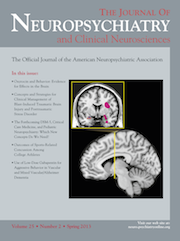Symptoms of Major Depression After Pseudoephedrine Withdrawal: A Case Report
To The Editor: Stimulant medications such as amphetamines are well-known to affect mood states. During use, subjects often describe having increased energy, motivation, and feelings of pleasure or well-being. Given these effects, attempts have been made to use stimulants in treatment of major depression, with some evidence of effectiveness when used in conjunction with conventional antidepressants.1
Withdrawal from chronic use of stimulants, especially highly addictive ones, is well known to produce a dysphoric state that resembles the clinical syndrome of major depression.2 This depressive withdrawal phenomenon appears to be more common in those with a preexisting history of major depression,3 possibly suggesting that stimulant withdrawal aggravates underlying depressive tendencies already present in the user. Indeed, the molecular mechanisms of withdrawal show many similarities to depression, leading some to propose that stimulant withdrawal may even serve as a useful model system for this complex syndrome.4
Pseudoephedrine is a sympathomimetic amine typically used for nasal congestion, and it is noted to have stimulant properties similar to other amphetamines. It is unclear, however, how it affects mood states. A previous report described an individual using it to self-medicate for symptoms of depression,5 and another report described a patient with psychosis showing signs of depression during withdrawal.6 In this report, we describe a patient with previously diagnosed major depression who showed improvement in depressive symptoms during use of pseudoephedrine and marked aggravation of symptoms during withdrawal.
Case Report
“Mr. A” is a 32-year-old white man with a history of attention-deficit hyperactivity disorder (ADHD) and major depression. He recently presented to the clinic to discuss an episode of worsened mood after attempting to treat sinus congestion.
In the past, the patient had been successfully treated for ADHD with methylphenidate, and he experienced one acute depressive episode several years ago that was treated with an SSRI. He was not taking either medication this year. Several months before this case presentation, the patient took a depression rating scale, the Quick Inventory of Depressive Symptoms (QIDS), and scored a 7, which indicates mild depression. He noted that this had been his usual baseline throughout for the past several months.
Two weeks before presentation, the patient had worsening allergy symptoms and nasal congestion. He was originally taking loratadine 10 mg and added pseudoephedrine 120 mg every morning. This led to improvement in congestion along with rapid improvement in depressive symptoms. His QIDS score during treatment with pseudoephedrine improved from the baseline of 7 to 3, which is in the range of clinical remission. After 2 weeks of treatment, the patient elected to discontinue pseudoephedrine, at which point his depressive symptoms notably worsened to a QIDS score 16, which indicates moderately severe depression. His specific symptoms on withdrawal were profoundly decreased energy level, decreased concentration, psychomotor retardation, increased appetite, increased need for sleep, worsening of mood (feeling sad more than half the time), and a worsened view of self. These depressive symptoms continued for 4 days after drug cessation, after which he noted a partial improvement, back to premedication baseline (QIDS of 7).
Discussion
Pseudoephedrine is an effective and commonly used congestion remedy known to have stimulant properties. It is thus surprising how few reports describe its interaction with mood. To our knowledge, this is the first report of simple unipolar depression appearing to benefit from initiating pseudoephedrine, and then significantly worsening during the withdrawal period. The timeline of withdrawal symptoms is in line with another report of 3 days,6 and is generally similar in duration to the acute physiological withdrawal experienced by those dependent on other stimulants.
Many primary care clinics treat both congestion and depression, and patients often present to clinic during episodes of congestion-related illnesses. We speculate that use of stimulant decongestants may affect the clinical assessment of mood during some office visits, especially in those patients with existing depression. This may potentially influence rates of antidepressant prescribing and referral to mental health specialists.
1 : The use of dopaminergic and stimulant drugs for the treatment of depression. J Psychosoc Nurs Ment Health Serv 2012; 50:11–14Google Scholar
2 : Abstinence symptomatology and psychiatric diagnosis in cocaine abusers: clinical observations. Arch Gen Psychiatry 1986; 43:107–113Crossref, Medline, Google Scholar
3 : The relationship between self-reported cocaine withdrawal symptoms and history of depression. Addict Behav 2001; 26:461–467Crossref, Medline, Google Scholar
4 : Alterations in serotonergic responsiveness during cocaine withdrawal in rats: similarities to major depression in humans. Biol Psychiatry 1998; 44:578–591Crossref, Medline, Google Scholar
5 : Self-medication with pseudoephedrine in a chronically depressed patient. Am J Psychiatry 1979; 136:1217–1218Crossref, Medline, Google Scholar
6 : Dependence and chronic psychosis with D-nor-pseudoephedrine. European Psychiatry: The Journal of the Association of European Psychiatrists 2003; 18:423–425Google Scholar



